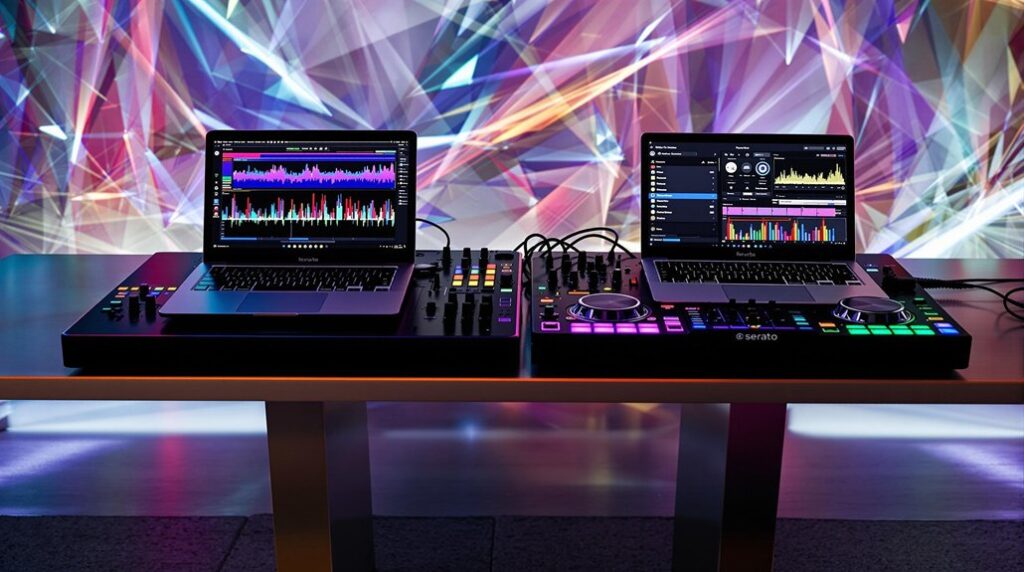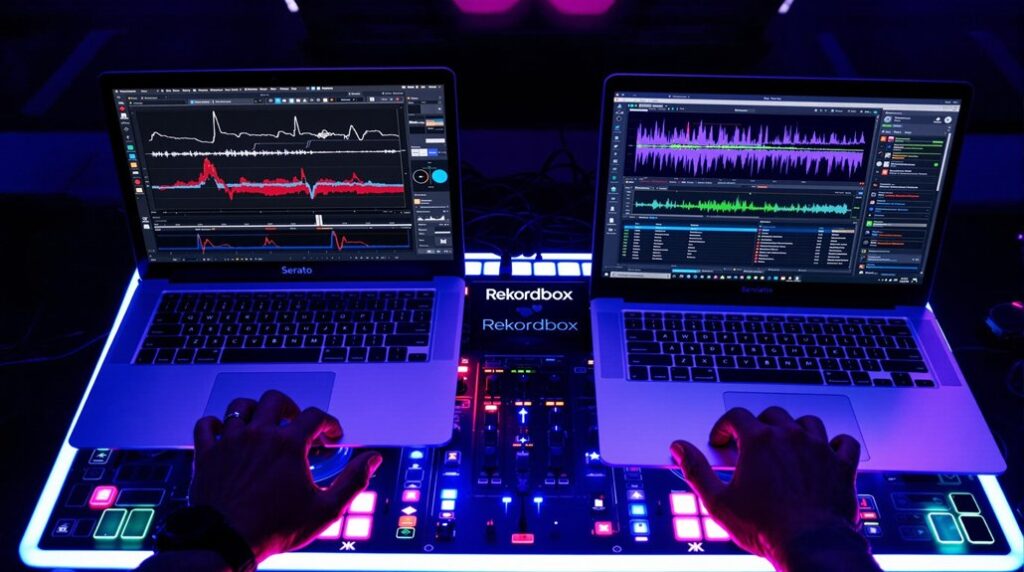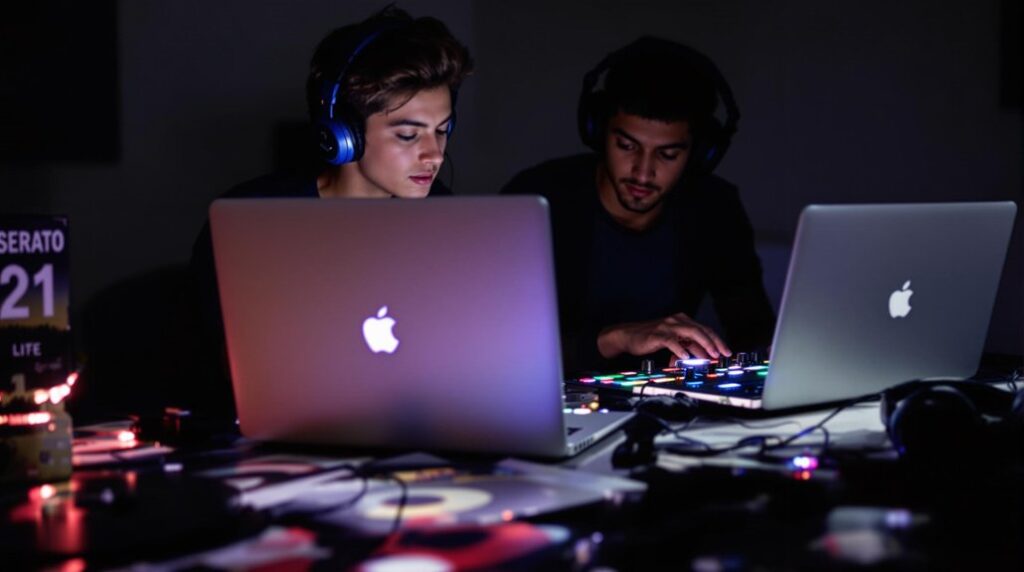DJ software caters to diverse DJing styles and performance needs. Serato DJ Pro and Virtual DJ are favored for live performances, offering extensive hardware compatibility and user-friendly features. Studio-oriented solutions like DJ.Studio and Traktor Pro focus on mix crafting and advanced features. Pricing models vary, with options for subscriptions or one-time purchases, affecting functionality expectations. By exploring various software options, DJs can better understand and align with their unique preferences, enhancing their performance capabilities.
Key Takeaways
- Evaluate your DJing style to choose between live performance-focused or studio-oriented DJ software.
- Consider software compatibility with your preferred DJ hardware for seamless integration and performance.
- Assess feature offerings like AI-driven tools, streaming access, and automation that enhance creative mixing.
- Explore pricing models, including subscriptions and one-time purchases, to fit your budget and usage needs.
- Test free trials or open-source options to experience software capabilities before committing financially.
Understanding Your DJ Software Needs
When selecting DJ software, how does one truly understand their needs? It begins with evaluating one's DJing style and preferences, as DJ software applications are tailored to various genres and mixing techniques. For those focused on live performance, Serato DJ Pro offers robust features compatible with popular DJ controllers, ensuring seamless hardware compatibility. Alternatively, a studio-oriented solution like DJ.Studio caters to those prioritizing crafting mixes over live gigs. Effective library management, including efficient track sorting, is essential for digital DJing, directly impacting performance. Additionally, financial considerations such as subscription models versus one-time purchases play a role in decision-making. VirtualDJ's real-time stem separation allows DJs to isolate vocals, drums, and bass for creative blending during live sets. The choice ultimately depends on weighing ongoing updates against initial costs, ensuring the software aligns perfectly with individual DJing aspirations and workflow.
Exploring Popular DJ Software Options
How does one navigate the diverse terrain of DJ software to find a perfect match? Each DJ software option offers unique characteristics tailored to different styles and preferences.
- rekordbox DJ is the club standard, excelling in seamless integration with Pioneer DJ gear and robust library management. Its free and paid plans cater to varying needs.
- Serato DJ Pro is favored by hip-hop enthusiasts, offering a user-friendly interface and robust DVS capabilities, available via subscription or purchase.
- Virtual DJ provides versatility with broad format support and an intuitive experience for all skill levels.
- Traktor Pro is ideal for electronic music with advanced looping and remixing features, offered as a one-time purchase.
- Algoriddim djay Pro integrates music streaming with AI-driven tools, enhancing accessibility and creativity across platforms.
In making the right choice, consider software like Ableton Live, which offers MIDI Mapping to enhance dynamic interaction, a crucial feature for those who value real-time manipulation in performances.
Evaluating Features and Functionality
In evaluating DJ software, the integration of AI-driven features such as automix and stem separation, exemplified by platforms like DJ.Studio and Algoriddim djay Pro, is essential for enhancing creative performance capabilities. Additionally, access to streaming services directly within the software expands the range of available tracks, ensuring DJs can adapt to various audience preferences in real-time. As these technological trends evolve, selecting software that incorporates these functionalities can greatly influence both the versatility and quality of a DJ's set. Djay Pro AI offers advanced mixing features like augmented reality control and customizable sampler modes, which can significantly enhance user engagement and provide dynamic effects during live performances.
AI Integration Possibilities
As AI technology permeates the sphere of DJ software, the integration of advanced features is reshaping the landscape of music mixing and performance. AI integration enhances the mixing process, offering precision in key detection and enabling real-time manipulation through advanced effects.
This technology allows DJs to engage in creative remixing by utilizing stem separation, which isolates track elements for dynamic live performances. Automation tools streamline tasks and improve performance quality.
- Automated Track Ordering: AI-powered features, like DJ.Studio's automix, optimize track sequence by analyzing key and tempo.
- Neural Mix: Algoriddim djay Pro's AI-driven capability isolates individual track elements.
- Enhanced Beatmatching: Serato DJ Pro and Traktor Pro use AI for accurate beatmatching.
- Dynamic Remixing: AI stem separation enables component isolation.
- Innovative Effects: Advanced automation tools foster creativity.
Streaming Service Access
While DJ software continues to evolve, the integration of streaming services marks a significant shift in how DJs access and utilize music libraries. Programs like Algoriddim djay Pro and DJ.Studio enable DJs to tap into extensive music libraries seamlessly, enhancing library management by offering real-time access to fresh music without the need for downloads.
Serato DJ Pro and Virtual DJ further amplify this by allowing real-time browsing and cueing, facilitating a dynamic mixing experience that adapts to audience response and trends. However, this access comes with subscription costs, which vary and can influence a DJ's budget.
Ultimately, streaming services within DJ software provide an essential tool for DJs seeking to stay current and responsive to their audience's evolving tastes.
Considering User Experience and Interface
In evaluating DJ software, the user experience and interface play a pivotal role in determining the suitability for different DJing styles. With user-friendly layouts like those found in DJay Pro and Cross DJ, accessibility becomes paramount, ensuring both novices and veterans can efficiently navigate the software. Meanwhile, customizable interfaces in Virtual DJ and the visual timeline approach of DJ.Studio highlight the trend towards flexibility and intuitive design, appealing to users who prioritize a tailored workflow. Additionally, AI-assisted software such as DJay Pro AI showcases innovative features for track analysis, enhancing the creative process for DJs.
How does one navigate the diverse terrain of DJ software interfaces effectively? User experience varies considerably, with options like DJay Pro and Cross DJ offering intuitive interfaces for seamless navigation.
Conversely, Serato DJ Pro and Traktor Pro present more complex environments, emphasizing advanced features that demand familiarity.
Key elements to take into account include:
- Visual track navigation: Graphical waveforms are essential for monitoring track progression.
- Cue points and live mixing: These features guarantee smooth conversions during sets.
- Customization: Programs like Virtual DJ allow interface personalization through plugins and skins.
- Hardware setups: Integration with hardware, as seen in rekordbox DJ, can enhance performance.
- Performance features: Options to incorporate effects and loops enhance creative expression.
Understanding these aspects allows DJs to optimize their software choice and performance efficiency.
Simplifying User Interactions
As DJ software continues to evolve, simplifying user interactions has become a pivotal trend, greatly enhancing accessibility for DJs at all skill levels. User-friendly interfaces, as seen in DJay Pro and Cross DJ, offer intuitive navigation and ease of use, ideal for mixing live without traditional DJ equipment. AI-driven features, like those in Algoriddim djay Pro, automate complex tasks such as track mixing, further streamlining the process.
| Feature | Software Example | Benefit |
|---|---|---|
| Intuitive Navigation | DJay Pro, Cross DJ | Simplifies use for all skill levels |
| AI-driven Features | Algoriddim djay Pro | Automates complex processes |
| Community Support | Mixxx | Enhances user experience and updates |
Free versions from Virtual DJ and Serato DJ Lite provide a risk-free introduction to essential features, supported by robust community engagement.
Examining Pricing and Subscription Models
Why do different DJ software platforms adopt varied pricing and subscription models? This stems from diverse user needs and market positioning. DJ software like Serato DJ Pro and Algoriddim djay Pro offers subscription models, enabling access to advanced features starting at $9.99/month and $6.99/month, respectively. Some platforms, such as Virtual DJ, provide a free version for home use, while others, like Traktor Pro 3, prefer a one-time purchase model at $99. DJ.Studio offers flexible pricing to cater to both casual users and professional DJs. Free trials are a common strategy, allowing users to experience features before committing financially. Serato DJ Intro offers basic functionalities suitable for new DJs, making it a popular choice for beginners. Key factors influencing pricing models include:
- User base segmentation
- Feature accessibility
- Market competition
- Technology advancements
- Consumer preference trends
Assessing Hardware Compatibility and Support
Pricing models often influence user expectations regarding software functionality and compatibility with hardware, which makes evaluating hardware support a critical aspect of choosing the right DJ software. Each program offers varying levels of hardware compatibility to suit different user needs.
Rekordbox DJ excels with Pioneer DJ gear, offering seamless integration, while Serato DJ Pro boasts strong compatibility with diverse DJ controllers, despite lacking USB export capabilities.
Traktor Pro integrates tightly with specific audio interfaces, appealing to electronic music enthusiasts. Virtual DJ is notable for its broad hardware support and customizable mappings, ideal for versatile DJing environments.
Meanwhile, Mixxx, as an open-source solution, supports a wide range of DJ hardware, allowing user contributions to enhance compatibility and functionality. For optimal audio quality, it is recommended to use high-quality, shielded cables to prevent audio loss when connecting hardware components.
Frequently Asked Questions
What Software Do Most DJS Use?
Most DJs prefer Serato DJ Pro for its reliability and user-friendly interface. However, an extensive DJ software comparison highlights Virtual DJ's versatility, Traktor's features, and rekordbox's hardware compatibility, influencing choices based on mixing techniques and music library management.
Do Most DJS Use Serato or Rekordbox?
Both Serato and Rekordbox are popular, with DJ preferences often influenced by Serato features like performance reliability and user interfaces, or Rekordbox benefits such as software compatibility and hardware integration. Cost considerations and mixing techniques also play roles.
What DJ Software Does Martin Garrix Use?
Martin Garrix's setup involves using Ableton Live, Traktor Pro, and Serato DJ Pro. His DJ software comparison reflects personal preferences influenced by industry trends, emphasizing live performance tools, user interface importance, compatibility with hardware, and impactful software updates.
Why Do DJS Prefer Serato?
DJs prefer Serato for its robust features, seamless hardware compatibility, and high performance. Its regular updates, diverse effects, extensive community, and thorough tutorials enhance its versatility. Serato's history and adaptability make it a trusted choice among professionals.
Conclusion
In an era where digital innovation shapes musical expression, selecting the right DJ software is paramount. By aligning software capabilities with individual style and technical needs, DJs can open up creative potential. Thorough evaluation of features, user interface, pricing models, and hardware compatibility is essential. As trends evolve, staying informed on emerging technologies guarantees DJs remain competitive and adaptable. Ultimately, informed choices empower DJs to craft seamless, dynamic performances that resonate with audiences worldwide.




